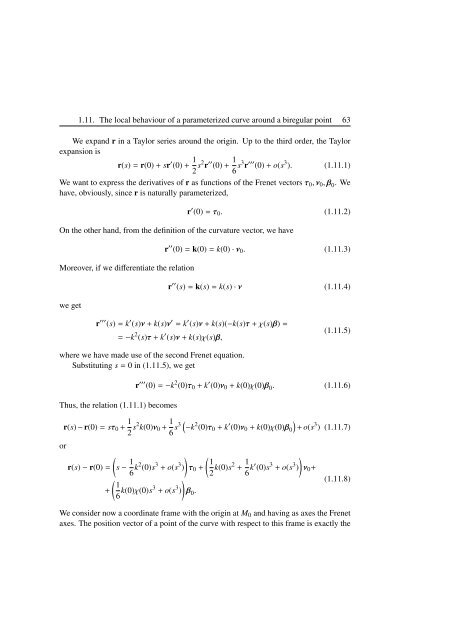Blaga P. Lectures on the differential geometry of - tiera.ru
Blaga P. Lectures on the differential geometry of - tiera.ru
Blaga P. Lectures on the differential geometry of - tiera.ru
Create successful ePaper yourself
Turn your PDF publications into a flip-book with our unique Google optimized e-Paper software.
1.11. The local behaviour <strong>of</strong> a parameterized curve around a biregular point 63<br />
We expand r in a Taylor series around <strong>the</strong> origin. Up to <strong>the</strong> third order, <strong>the</strong> Taylor<br />
expansi<strong>on</strong> is<br />
r(s) = r(0) + sr ′ (0) + 1<br />
2 s2r ′′ (0) + 1<br />
6 s3r ′′′ (0) + o(s 3 ). (1.11.1)<br />
We want to express <strong>the</strong> derivatives <strong>of</strong> r as functi<strong>on</strong>s <strong>of</strong> <strong>the</strong> Frenet vectors τ0, ν0, β0. We<br />
have, obviously, since r is naturally parameterized,<br />
r ′ (0) = τ0. (1.11.2)<br />
On <strong>the</strong> o<strong>the</strong>r hand, from <strong>the</strong> definiti<strong>on</strong> <strong>of</strong> <strong>the</strong> curvature vector, we have<br />
Moreover, if we differentiate <strong>the</strong> relati<strong>on</strong><br />
we get<br />
r ′′ (0) = k(0) = k(0) · ν0. (1.11.3)<br />
r ′′ (s) = k(s) = k(s) · ν (1.11.4)<br />
r ′′′ (s) = k ′ (s)ν + k(s)ν ′ = k ′ (s)ν + k(s)(−k(s)τ + χ(s)β) =<br />
= −k 2 (s)τ + k ′ (s)ν + k(s)χ(s)β,<br />
where we have made use <strong>of</strong> <strong>the</strong> sec<strong>on</strong>d Frenet equati<strong>on</strong>.<br />
Substituting s = 0 in (1.11.5), we get<br />
Thus, <strong>the</strong> relati<strong>on</strong> (1.11.1) becomes<br />
or<br />
(1.11.5)<br />
r ′′′ (0) = −k 2 (0)τ0 + k ′ (0)ν0 + k(0)χ(0)β 0. (1.11.6)<br />
r(s) − r(0) = sτ0 + 1<br />
2 s2k(0)ν0 + 1<br />
6 s3 � −k 2 (0)τ0 + k ′ �<br />
3<br />
(0)ν0 + k(0)χ(0)β0 + o(s ) (1.11.7)<br />
r(s) − r(0) =<br />
+<br />
�<br />
s − 1<br />
6 k2 (0)s 3 + o(s 3 �<br />
)<br />
� 1<br />
6 k(0)χ(0)s3 + o(s 3 )<br />
�<br />
1<br />
τ0 +<br />
2 k(0)s2 + 1<br />
6 k′ (0)s 3 + o(s 3 �<br />
) ν0+<br />
�<br />
β0. (1.11.8)<br />
We c<strong>on</strong>sider now a coordinate frame with <strong>the</strong> origin at M0 and having as axes <strong>the</strong> Frenet<br />
axes. The positi<strong>on</strong> vector <strong>of</strong> a point <strong>of</strong> <strong>the</strong> curve with respect to this frame is exactly <strong>the</strong>












